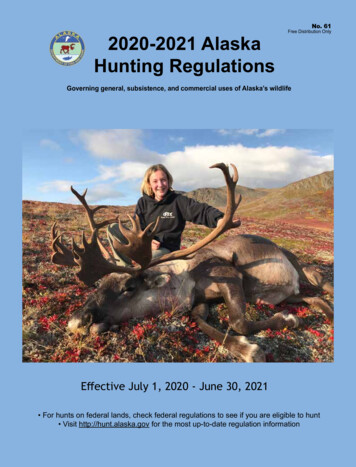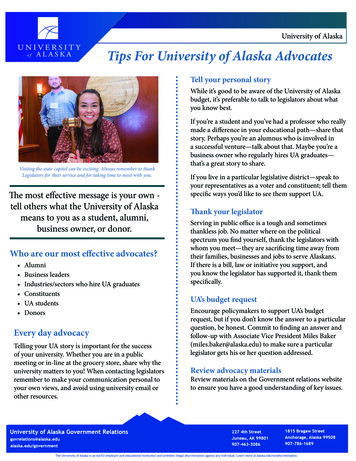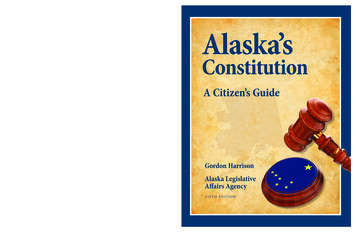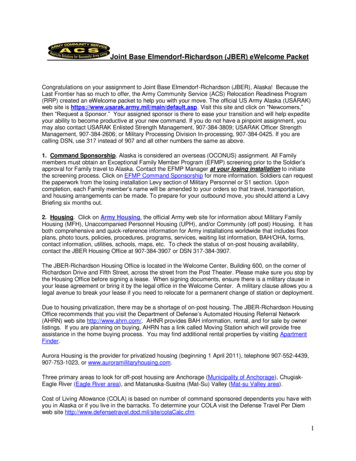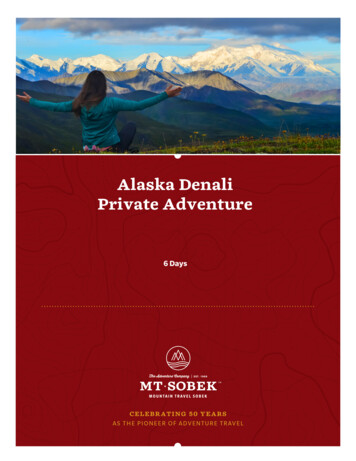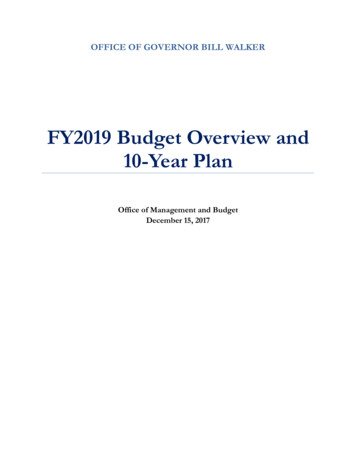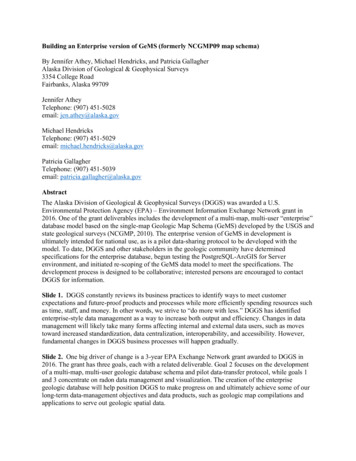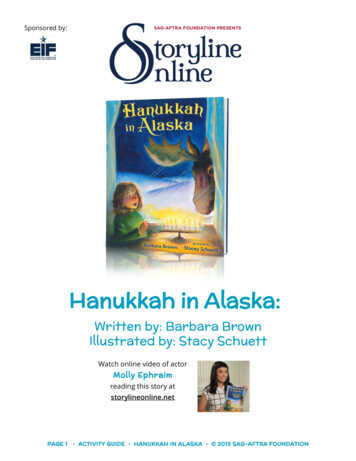
Transcription
Sponsored by:SAG-AFTRA FOUNDATION PRESENTSHanukkah in Alaska:Written by: Barbara BrownIllustrated by: Stacy SchuettWatch online video of actorMolly Ephraimreading this story atstorylineonline.netPAGE 1 ACTIVITY GUIDE HANUKKAH IN ALASKA 2015 SAG-AFTRA FOUNDATION
BOOK SUMMARYDuring one dark, cold, snowy Alaska winter, a young Jewish girl finds a moose who willnot leave her yard. As the Hanukkah holiday approaches, she grows more and morevexed with this giant animal who threatens her most precious play object, her blueswing. One night during Hanukkah, her father shows her the spectacular NorthernLights, and an idea comes to her on how to rid herself of the moose once and for all,proving that miracles can happen to anybody anywhere.DISCUSSION POINTSALASKA Ask students to share the images, ideas, and words they associate with Alaska. Make aword wall to display them. Explain Alaska’s long hours of darkness in winter and ask students how they thinkit would feel to live in extended darkness. Have students share ways their day-to-daylives would need to change in order to adapt. Show students pictures of Alaska, noting the absence of roadways common in theLower 48. Ask students how they think Alaskans get around and what they think oftheir modes of transportation. Students may make desk signs advertising atransportation business they would like to run if they lived in Alaska:helicopter, dog sled, snowmobile, big rig truck, canoe, nt/index Ask students to hypothesize what they think people and animals do to survive in aconsistently cold, snowy, and often dark environment. Make a comparison chart and have students share the ways Alaska differs from wherethey live: industry, housing, transportation, weather, food, geography.(environments with extreme weather, animals and people who’ve adapted to extremeenvironments, living in snow and cold, extended darkness)WILD ANIMALS Talk about where we might see wild animals: habitats, times, environments, seasons,travel paths.Give each student two pictures: one domesticated animal, one wild. Have themexplain how these animals are different, physically and socially.Make a chart with two columns: Should and Shouldn’t. Have children name a wildanimal and chart how we should and shouldn’t behave around that animal.PAGE 2 ACTIVITY GUIDE HANUKKAH IN ALASKA 2015 SAG-AFTRA FOUNDATION
Talk about the physical features for specific animals when considered alongsidetheir habits and habitats: water, above and below ground, aerial, nocturnal, seasonal.Have students talk about why they think these animals have these specific features.(animal habitats and traits, safety techniques for specific animals, dangerous animals, wildanimals vs. domesticated) DARKNESS Talk about when we have darkness, both naturally and artificially.Make a circle chart and fill in what the students have to say about the seasons, light anddarkness, and activities during those times.Discuss the night sky and the day sky: what makes them so different?Make a feelings charts for how darkness can make us feel and why.(when and where darkness occurs, seasons and changing length of daylight hours, the night skyvs. the day sky, darkness and feelings)HOLIDAYS Talk about holidays: what are they, why we have them, do we all celebrate the sameones, when they happen, what we wear, eat, and do on these holidays.Discuss the differences between religious, civic, and personal holidays.Have students list all the holidays they know and write them on slips of paper. Post alarge calendar and have students place them in the month or season they occur.Have students talk about their most and least favorite holiday and why that is.Have students name the most common symbols for holidays they know.(types of holidays, ritual, holidays that move with the calendar)COLOR AND LIGHT Talk about where we see color, both in nature (including in us) and artificially. Talk aboutcolor changes (ex: flowers that fade and die) and colors that stay the same (ex: eyes).Show students the color wheel and ask them to name all the colors. Talk about how eachcolor makes them feel and why they think that is.Talk about soft/watery and intense/saturated colors and what our impressions of themare, what words we would use to describe them, where we see them.Talk about why the colors of the rainbow or spectrum are in the order they are.Talk about black and white and whether or not they are colors.(where do we see a lot of color, how do colors make us feel, soft/watery colors vs. intense/saturated colors, colors of the rainbow)PAGE 3 ACTIVITY GUIDE HANUKKAH IN ALASKA 2015 SAG-AFTRA FOUNDATION
ACTIVITIES In the story, the family experiences the Northern Lights. Set up progressive sciencestations where students learn how Auroras are made. Using paint, fabric, colored tissuepaper, cotton batting, and crayon, have students make a 3-D Aurora Borealis ceilingthat is hung over their classroom. Assign roles to students and have them write a shortinformative play that tells all about Auroras. Invite parents or other classes to watchtheir play under the Northern Lights. Roles may include the sun, moon, stars, the solarwind (coronal mass ejection), the earth’s protective field, ions, and the poles. Encouragestudents to move, sound, and dress like their scientific element. At the end of the play,turn out the lights and have students without narration roles use flashlights and fansto animate the Aurora Borealis on the ceiling. Afterward, play a video showing the realAurora Borealis and let the students and audience dance. (You may also record theperformance and hold a movie screening, serving sno-balls or popsicles as treats.)http://www.kidsastronomy.com/Aurora article.phphttps://www.youtube.com/watch?v fVsONlc3OUY(earth science: Aurorae creation, light phenomena, Earth’s sky, ions and particles; art: reproducingnatural phenomena, color patterns, creating a backdrop; theater arts: making an informativeplay, portraying inanimate objects and natural occurrences, using light to create movement;dance: interpreting nature) One of the traditions the family in the book observes is lighting the Menorah. Havechildren make a star, web, or tree organizer for one tradition their family observes.Students may include feelings about the tradition, people who attend it, when thetradition is observed, and any details that personalize it. Then, using heavy paper and astapler and ribbon, make a vest, apron, or cape for each child. Have students decoratethe item using pictures, words, actual items, etc., that document their tradition. They maybring these items from home or create them in the classroom. Have a Traditions Paradethrough the school then have students give an oral report using their item of clothing astheir report notes. You may display the clothing in a traditions corner in your room orhang them from the ganizers/star/(art: making clothing, using symbols to convey facts; language arts: pre-writing, organizing details;social studies: documenting tradition, preserving family history, nonverbal communication) The illustrations in Hanukkah in Alaska are strikingly color-saturated. Have students usecolored markers to cover large pieces of heavy white paper with thick, solid colors. Nexthave them cover the paper with black crayon. Students may use toothpicks or woodskewers to etch lightly a picture into the black crayon, revealing the rainbow of colorunderneath. Students could also employ geometric shapes, repeating patterns,PAGE 4 ACTIVITY GUIDE HANUKKAH IN ALASKA 2015 SAG-AFTRA FOUNDATION
or monotone colors when creating the colored underlayer. You may also direct themto replicate an Alaskan animal, aspect of the story, or a holiday symbol for the etching.Display the color wheel if you like and discuss hues, tints, shades, tones, and oppositeand complementary s: color progression, patterns and shapes, multilayered art, etching, replication, the colorwheel; geometry: shapes; math: repeating patterns) Hanukkah is an important event for the characters in Barbara Brown’s story. Dividestudents equally into five groups. Working with your librarian, create Holiday stationswith magazines, books, audio files, and websites so each group learns about one offive major religious holidays that occur in December: Christmas, Eid al-Fitr (not alwaysbut often in December), Hanukkah, Kwanzaa, and Yule. Have each group create a largediorama detailing their holiday. Post a written report describing what is taking place inthe diorama. Students may host a progressive dinner party where each group bringsclothing, food, and music appropriate to their diorama and narrates the scene for visitorswho move from one holiday diorama to the n: winter holidays, traditions, religious differences; history: dioramas, communicatingfacts through visuals; social studies: holiday food, clothing, and music, progressive dinners;theater arts: role play) This story takes place in a very snowy place. Review science terms such as atoms,temperature, water, vapor, ice, and snow then show the short video about howsnowflakes form. Using a small Styrofoam ball as their dust particle, have each studentbuild a snowflake using glue, colored gel sheets, waxed paper, aluminum foil, pipecleaners, toothpicks, cotton balls, Q-tips, and glitter. Have them document their snowflakeformation step-by-step in a book. You may take pictures of the forming snowflakes orhave students illustrate the book by hand. To add drama and art to this assignment,students may have the snowflake narrate the story of its creation in the book. Displaythe snowflake chart for guidance and hang the finished flakes in the window. Childrenwill also like to “grow” their own snowflake using the recipe below. The next day, havestudents compare and contrast the snowflakes using a two-column tch?v jbxUEE2L8zohttp://www.its.caltech.edu/ stal-snowflakePAGE 5 ACTIVITY GUIDE HANUKKAH IN ALASKA 2015 SAG-AFTRA FOUNDATION
(earth sciences: weather, snow, the water cycle, temperature, artificial snow; art: models,replication; geometry: shape names, sides, arms; social studies: steps in a process, chartingcharacteristics; language arts: compare and contrast vocabulary, animating inanimate objects) Post a large map of Alaska on the wall and delineate its four zones: Far North, Interior,South Central, and Southeast. Break students into four groups and have them chartthe information provided to show the geographic features, weather, elevations, andpopulation data as well as the major cities in the region. Post the charts and breakstudents into teams. Using a spinner, have students answer questions based on thedata posted. Keep score and reward the winning team. Let students illustrate the papermap, adding flora, fauna, and aquatic life with magazine pictures, drawings, and variouspapers. For expanded geography work, students may use the compare and contrastmethod for Alaska and the Lower 48 or countries on the same -62915.html(geography: mapping data, reading maps; language arts: vocabulary; social studies: specificregions; earth science: animals and plants of specific regions) Create a board game! Children can make question cards using specific moments fromthe book. Why do moose kick things? (They get surprised); How many hours of daylightdoes Alaska have in winter? (five); What should you do when it’s very cold outside? (wearmultiple layers of clothing); Name one tradition of Hanukkah. (lighting the menorah); etc.Break into small groups and have each group make a board game decorated with imagesfrom the book, symbols of Alaska, and blocks of color. The board should include “moveahead” (ex: got moose to leave the yard), “go back” (ex: feel asleep in class because it wasdark outside), and “special bonus” blocks (ex: snow day, no school!). Students may be ascreative as they like, making circular, snaking-, helix-, or other-shaped paths on the board.Using a die and game pieces, one person draws a question card from the pile and theperson whose turn it is gives the correct answer from the book in order to move forward.When they are finished playing their version, have the groups switch until all childrenhave played all versions.https://www.youtube.com/watch?v r-7IvAnDCDEhttps://www.youtube.com/watch?v SRiRw1RhHGA(music: creating emotion with music; math: numbers, shapes; language arts: poetic style, usingwords to convey mood, pre-writing, finding inspiration)PAGE 6 ACTIVITY GUIDE HANUKKAH IN ALASKA 2015 SAG-AFTRA FOUNDATION
Alaska is home to some of the world’s largest and most beloved mammals. Make a Bingoboard with names or pictures of the animals and plants found in Alaska. Five columnsacross and five down. Call out a characteristic of each animal or plant in order to coverthat spot. Bingo!http://www.adfg.alaska.gov/index.cfm?adfg animals.listmammals(science: mammals, physical attributes of various mammals, regional wildlife; language arts:recalling facts, competition) Throughout much of this story, the snow creates moods and dictates activities. Showstudents these two radically different short films featuring snow. Brainstorm pre-writingwords and phrases in two columns, one for each video. Have students write a poeminspired by the one of videos. Remind students that a poem is a short story and has abeginning, middle, and end. You may introduce formalize poetic style if you like: Haiku,rhyming couplets, free verse, limerick, or concrete poetry (written in the shape of anobject). Afterward, you may play a guessing game wherein the author reads the poemand classmates guess which video inspired it.1. https://vimeo.com/576952312. https://vimeo.com/116002328(music: creating emotion with music; language arts: poetic style, using words to convey mood,pre-writing, finding inspiration) Alaskans live many months with very little daylight, unlike other residents of the US. Withlarge rectangular boxes create dark and light stations by cutting two holes on the front ofthe box: one for light source, one for observation. Set up the interior of each box to showvarious aspects of light: color, reflection, light travel, light bending, and light waves. For colorreflection use bananas or oranges; for light travel use cards with holes for the light to passthrough or be blocked; for light bending use a mirror or curved prism; and for light waves usea prism. Have students make rainbow name tags identifying them as Light Scientists and fillout information sheets that help them organize their findings. The next day, have childrencome dressed in a color or aspect they learned about and tell the class their properties: atranslucent object, an orange, a prism, how fast or slow their wave lengths travel, whetherthey reflect all, some, or no light, etc. As a treat, you may hang faceted crystals, turn out thelights, and use a flashlight and fan to make rainbows, having children dance under them. Youmay refer to this video to see expanded ideas on the boxes.https://www.youtube.com/watch?v science-lesson-on-light(science: properties of light travel, light waves, light absorption and reflection, rainbows; art:becoming an inanimate object; language arts: light vocabulary)PAGE 7 ACTIVITY GUIDE HANUKKAH IN ALASKA 2015 SAG-AFTRA FOUNDATION
The snow in Alaska is highly reflective, sending back all colors in the spectrum. Brainstormvocabulary words and terms for light reflection and absorption. Hand out notebooks andflashlights (make sure the batteries are good and the light beam is strong!) and walk yourcampus. Take students to preset objects and using their flashlights, have them determinewhich reflect light the most, which the least, and what color each object absorbed.Students will chart their results in a notebook, then translate it to picture diagrams. Coversticks from trees with glitter and make a mobile with the diagrams. For added sparkle,hang crystals, pieces of reflective paper, or small mirrors among the diagrams. Forincreased reflectivity, paint the backs of the diagrams with glow-in-the-dark paint or gluealuminum foil to them.https://www.youtube.com/watch?v CAlkmo0hK0k(science: light reflection and absorption, measuring reflectivity, comparing object nature; art:mobiles; language arts: light vocabulary, note taking) The delicious latke is featured in the story. Read the simple list of ingredients, writing thewords on the board: potatoes, onions, eggs, flour, oil, salt, and pepper. Have studentstalk about the ingredients: how do they grow, which parts do we eat or not eat, what isour favorite way to eat them. Also discuss the ways in which we cook food: boiled, baked,fried, microwaved, or uncooked. Make a wall chart for the various ways to prepare foodand have students put their names under the method they think will make the besttasting latke. Bring in a burner, pot, pan, toaster oven, microwave, and mixing bowl. Havethe ingredients pre-grated and measured and have students mix the latke batter (youmay use five different bowls for the five different methods). Break students into foodscientist groups, one for each method, and make one latke at a time, using the variousmethods. Have the student food scientists describe on the wall chart what happenedto their latke and rate its appeal. After your experiment, have students make hangingStars of David using popsicle sticks, paint, and glitter while you fry latkes. Serve withapplesauce and sour cream. For expanded learning, study the life cycle of potatoes,onions, and wheat, as well as how salt, pepper, and oil are produced.(science: prediction, reaction of food to heat, how appearance affects perception, cookingmethods, charting results, the life cycles of tubers, bulbs, seeds, grains, and salts; social science:personal preferences, cultural traditions, cooking methods; art: religious symbols; language arts:descriptive words)PAGE 8 ACTIVITY GUIDE HANUKKAH IN ALASKA 2015 SAG-AFTRA FOUNDATION
RESOURCESALASKAOnce Upon Alaska: A Kid’s Photo Book by Mark Kelley and Nick JansThe Toughest Race on Earth: Iditarod. On-Demand or DVDDenali Park, interactive DVD game: pxIndie Alaska, Alaska Public Television short film series: https://www.youtube.com/watch?v fRRqHKlCiKIAlaska Bingo, Geography edition: eMarsh/dp/0635002345Gold rush video game: sh.htmlOff to the Klondike! Search For Gold, video: http://watchknowlearn.org/Video.aspx?Fun Facts Alaska Wildlife Wood jigsaw puzzle by MasterPieces: pany-Wildlife-48-Piece-Elovarra/dp/B000PCIJ6U/ref sr 1 1?ie UTF8&qid 1447793238&sr 8-1&keywords Fun Facts Alaska Wildlife Wood Jigsaw PuzzleColor Me!, Alaskan animal coloring book with facts: cabee! The Story of Hanukkah by Tilda BalsleyThe Everything Kids’ Hanukkah Puzzle & Activity Book by Beth L. Blair and Jennifer A. EricssonThe Runaway Latkes by Leslie KimmelmanHanukkah Sweets and Treats (Holiday Cooking for Kids!) by Ronne RandallFunnukkah Hanukkah Doll and Illustrated Book, girl or boyThe Magic Dreidels: A Hanukkah Story by Eric KimmelHanukkah At Valley Forge by Stephen KrenskyHanukkah Moon by Deborah Da CostaPAGE 9 ACTIVITY GUIDE HANUKKAH IN ALASKA 2015 SAG-AFTRA FOUNDATION
LIGHTThomas Edison for Kids by Jacob SmithAurora Borealis poster: Snorthern/dp/B00BGTAVFS/ref sr 1 1?ie UTF8&qid 1436894302&sr 8-1&keywords Aurora Borealis posterUnder Alaska’s Midnight Sun (PAWS IV) by Deb VanasseLights, Mirrors, and Lenses: A Ladybird junior science book by Frank Edward NewingHanging crystal rainbow maker: cienceWiz/Light Experiment Kit: http://www.amazon.com/s/ref nb sb noss?url searchalias%3Daps&field-keywords %09ScienceWiz%2FLight Experiment Kit&rh i%3Aaps%2Ck%3A%09ScienceWiz%2FLight Experiment KitSNOWInsta-Snow: Gallons/dp/B000FA6APESnowboarding video game: http://www.freeonlinegames.nameWhy Does It Snow? by Chris Arvetis and Carole PalmerWhen It Snows by Richard CollinridgeSnow Facts & Fun by Ms. A B MacSnow Babies/Polar Bears: Spy on the Ice, DVDINDIGENOUS PEOPLE OF ALASKA“Never Alone,” video game of Native Folklore: http://neveralonegame.com/game/ (click “Buy Now”)Alaskan Children Paper Doll Cut-out Book (#20209) by Arctic Circle EnterpriseAlaska’s First People by Judy FergusonTotem Tale (PAWS IV) by Deb VanasseMake your own totem pole: http://mrnussbaum.com/inttotem/ and http://mrnussbaum.com/totem1/Totem.swfPAGE 10 ACTIVITY GUIDE HANUKKAH IN ALASKA 2015 SAG-AFTRA FOUNDATION
Native Alaskan Dancer: https://www.youtube.com/watch?v IMS2xWVw5LwTraditional Native Alaskan housing: https://www.trails.com/how 6976 build-own-teepee.html(link to traditional housing book series at bottom of page)ABOUT THE AUTHORBarbarabrown.alaskawriters.comABOUT THE ILLUSTRATORStaceyschuett.comABOUT THE READERhttp://www.imdb.com/name/nm1454378/?ref fn al nm 1ABOUT STORYLINE ONLINEThe SAG Foundation’s children’s literacy website Storyline Online streams imaginativelyproduced videos featuring celebrated actors to help inspire a love of reading.Storyline Online receives millions of views every month in hundreds of countries.Visit Storyline Online at storylineonline.netABOUT THE SAG-AFTRA FOUNDATIONThe SAG-AFTRA Foundation provides vital assistance and educational programming to theprofessionals of SAG-AFTRA while serving the public at large through its signature children’sliteracy programs. Founded in 1985, the Foundation is a national non-profit organization,independent from SAG-AFTRA, and relies solely on support from grants, corporatesponsorships, and individual contributions to maintain our programs and create new ones.For more information, visit sagaftra.foundation.STORYLINE ONLINE BROUGHT TO YOU BYPAGE 11 ACTIVITY GUIDE HANUKKAH IN ALASKA 2015 SAG-AFTRA FOUNDATION
Make a comparison chart and have students share the ways Alaska differs from where they live: industry, housing, transportation, weather, food, geography. Talk about where we might see wild animals: habitats, times, environments, seasons, travel paths. Give each student t
